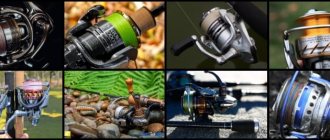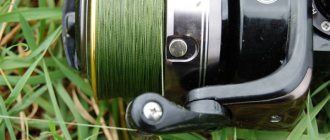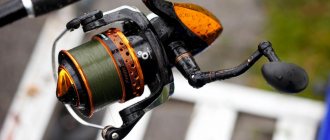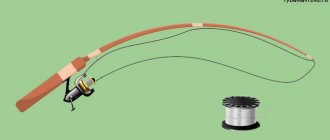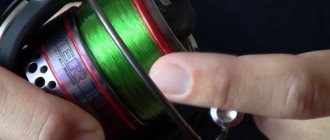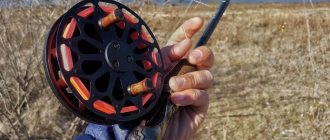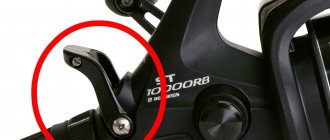Bobbin size
The size of the spool depends on the fishing method and the thickness of the fishing line. On reels you can find some values of 1000, 2000 or 5000. The number 1000 shows that the spool can hold 100 meters of fishing line with a thickness of 0.1 mm, and the number 3000 can hold one hundred meters of fishing line with a thickness of 0.3 mm.
- For light spinning (ultralight), reels with 1000-2500 spools are usually used.
- For medium spinning rod: 2500-3500.
- For heavy spinning, 4000+ spools are used.
- For feeder fishing, use reels with 2500-5000 spools.
- For carp fishing 5000+.
| Braid selection | Swimbait fishing | Types of inflatable boats | Chub fishing |
The size and depth of the spool should be selected depending on the length and diameter of the fishing line you are using and the casting distance of the bait.
How to choose
Experts and experienced fishermen identify several main characteristics that you need to pay attention to when selecting:
- Smooth running when winding. Allows you to evenly wind the fishing line onto the reel drum, avoiding jerking of the spoon when casting and fishing for fish. Types of winding are cylindrical, with a straight or reverse cone. An important factor: only the latter type is suitable for braided fishing line. Regardless of the shape, the tackle, when reeling in, should not lie in waves, otherwise it will get tangled when casting, forming so-called “beards”.
- Drum (shipuli) size. They are indicated in the coil characteristics in numbers that are multiples of a thousand: 1,000, 2,000, 3,000, etc. This means that 100 m of 0.1 mm thick line can be wound onto the reel. It is easy to calculate the maximum length of the reeled fishing line of other thicknesses.
- Pay attention to such a detail as the bow for laying the fishing line. The fishing line should be strictly on the winding roller with the bow closed and not cling to anything. The roller must rotate and have a bearing.
- Friction braking element. Available in various designs - front or rear. When a large fish jerks strongly, it releases the line, preventing it from breaking. Experienced fishermen prefer the front clutch, since due to the design, the rear clutch may not always work. However, many people prefer the rear brake; it is more convenient to adjust the tension while fishing.
- Total weight of the device. Parts of reliable devices are made of metal, which allows them to withstand heavy loads. If a different, lightweight material is used, the reel will be lighter and more maneuverable, but it may break under load. Lightweight reels typically last no more than two seasons and are suitable for beginners as an inexpensive option to gain experience. So the last thing you need to focus on is weight.
- Spinning reel handle. As a rule, they are screwed in, secured with a screw or rivet. Pay attention to the reliability of the thread (must be large) and the quality of the riveted connection, in order to avoid the handle breaking off under load. There are also models with the ability to change the mounting side, for the convenience of “right-handed” and “left-handed” people.
A few more tips:
- It is best to purchase a reel with a spinning rod in hand. Then you can immediately check the balance of the assembled gear in order to choose the most convenient option for further use at the fishing spot.
- If you plan to use a spinning rod for fishing from the shore , using fairly heavy lures, the optimal length of the rod should be 2.7 - 3.5 m. For such characteristics, a reel with a spike volume of 2,500 or higher is required. When the spinning rod does not exceed 2.7 m and you use light baits, purchase a reel with a volume of 1,500 - 2,000.
- Another characteristic is the gear ratio of the reel , which determines how many turns the handle must be made to wind one circle of fishing line.
- It is determined empirically for each individual angler , although there are recommended values that depend on the planned weight of the catch.
- Another important criterion for selection is its manufacturer and the cost of the equipment.
Let's figure out what is being offered to us now.
Spool shape
Deep spools hold a larger amount of fishing line, the casting range with such spools is low, and are used for thick braided or monofilament fishing line.
Shallow Air Spool spools are mainly used for thin braided lines. Typically, such spools have an increased diameter.
Long Cast spools are commonly used on carp reels. The long cone-shaped spool provides good capacity and long casting.
There are also reverse taper spools that are used for spinning reels. The reverse cone eliminates loop shedding and reduces the risk of line tangling.
Spool material
The spool can be made of either plastic or metal.
It is better to avoid plastic spools, as they wear out quickly and have high friction. Braid on plastic spools will not be used.
Metal spools are usually made from aluminum, while more expensive ones are made from titanium or composites. There are also aluminum spools coated with titanium nitrite, which have a very smooth surface, wear resistance and strength.
Reels with hard-coated aluminum spools are much more expensive than regular reels.
| Aluminum boats | Coastal echo sounders | Types of jig heads | Carp rods |
Friction clutch
An element of a spinning reel that allows you to release the cord or line when reeling in a fish so as not to tear the line or the fish’s lip. With strong jerks, you need to let the fish unwind the line from the reel, as the fish gets tired and cannot break the line. The clutch can be rear or front.
For spinning, reels with a front drag are usually used.
For feeder or carp fishing, reels with a rear drag and a baitrunner are used.
The front clutch is considered more sensitive and more reliable and is more finely adjusted.
Inertia-free coils
Of all the popular types of fishing gear, only fly rods are not equipped with a reel. But in order to choose the right reel for feeder, spinning, match, carp fishing or trolling, you need to take into account a number of points, which will be discussed in this article.
Main characteristics of fishing reels - gear ratio
The gear ratio indicates how many revolutions the spool will make per revolution of the handle. Typically this value ranges from 3.6:1 to 7:1. The lower the value, the lower the rewinding speed will be, and the traction force on the spool will be greater.
Classification of coils by gear ratio:
- from 3.6:1 to 4.7:1 is considered to be power;
- from 5.0 to 5.7 – universal;
- from 6:1 to 7:1 – high-speed.
Friction clutch
This is a reel brake with smooth adjustment of force. Its mechanism can be located behind the spool, or directly in it. Accordingly, the brake adjustment knob can be located differently:
- behind the reel body is the “rear clutch”;
- in front of the spool is the “front clutch”.
Reels with rear drag are more convenient for adjustment during fishing. But they have a bulkier and heavier design, and the brake mechanism is prone to self-tightening.
Products with a front clutch are lighter, but operating the brake requires some skill, and the clutch mechanism is more susceptible to clogging and needs periodic cleaning.
For certain types of reels, the placement of the clutch is determined by the design features and their purpose. Thus, carp variants with a baitrunner can only be equipped with a rear clutch. Lightweight and high-speed match reels are available only with a front brake.
Spool
Characterized by its own dimensions and material of manufacture. Cheap reels are equipped with plastic spools, while more expensive ones are made of aluminum alloys coated with titanium nitride. The spool's specifications indicate the amount and diameter of fishing line it can hold.
Shallow and wide spools are designed for winding thin lines. To use thin line on deep spools, a layer of thicker line (backing) is usually pre-wound, thus leveling the depth of the spool, increasing the diameter of the winding, and the layer of working line rises to the side.
Additional braking mechanism - beatrunner
The baitrunner makes it possible to freely remove the line from the spool when a fish bites, while the main brake remains tightened. The mechanism is turned off automatically by turning the reel handle, after which the main brake comes into play and slows down the spool with the force for which it was set in advance.
The system significantly increases the complexity, weight and price of the reel. It is mainly used in carp fishing, as well as when catching large fish on a feeder in still water.
Number of bearings
The bearing is a precision mechanism, so it is not cheap, but it is necessary to suspend the main shafts of the reel so that it operates smoothly and reliably. Manufacturers often indicate the number of bearings directly on the packaging. For an average reel, 4 to 6 bearings are sufficient. A large number is an advertising campaign of unreliable manufacturers - most fishermen are inclined to this opinion. What is much more important is not the quantity, but the quality of steel, lubricant, housing, i.e. security of internal mechanisms….
Classification of fishing reels by purpose
This is a conditional division of coils by purpose. There are no clear boundaries determined by technical characteristics between classes of coils. Coils are usually divided according to the method of application into:
- spinning,
- trolling,
- match,
- carp,
- feeder
Spinning
They are also called universal. Their gear ratio is in the range of 5.0:1 – 5.7:1. On store shelves you can find a huge variety of such reels. There are both the lightest samples, for thin lines and minimal bait weights, and very powerful options for deep-sea wobblers. This makes it possible to select spinning reel models for other types of fishing. Such reels are widely used by fishermen for various types of bottom fishing, and lightweight reels are installed on match and Bolognese fishing rods.
Trolling
That means powerful. On average, their gear ratio is 4.0:1. The powerful design allows for power pulling. They are also used in spinning rods for power retrieving very heavy and deep-sea baits, also in feeder fishing in fast current conditions with large feeder weights, as well as in carp fishing.
Match
They are subject to the following requirements:
- minimum weight so that the fishing rod remains comfortable;
- maximum speed for quickly removing light equipment from the water.
The gear ratio tends to 7.0:1. They are equipped with shallow and large spools for thin fishing line. Can be used in light feeder and even for spinning fishing.
Carp
Their distinctive feature is the increased power of the elements and the presence of a batrunner. The name speaks for itself. Also, very often, anglers install a similar class of reels on powerful feeder rods for catching large fish in still water and in the current.
Feeder
In fact, it is even difficult to single out such a class unless the manufacturer himself declares it. Application conditions dictate conflicting requirements. On the one hand, a high reeling speed is desirable, and on the other hand, sufficient power is needed to pull out heavy feeders with large fish, and even against the current. In general, they are match reels in a “carp” design.
How to choose a fishing reel
The price for which you can buy a quality reel cannot be small. A normal middle-class product made of high-quality materials, which contains precisely assembled mechanisms and 4 - 5 bearings, cannot be cheaper than 40 USD.
If a reel costs less, it means that everything is simplified, and the materials that should be used are replaced with incomprehensible surrogates. For example, often the spool is made from “nobody knows what it is” with yellow paint on the side instead of titanium nitride.
When choosing a reel, you should not chase the number of bearings. 4 pcs is quite normal and acceptable for a reliable product in the mid-price range.
You should immediately check the reel for spontaneous closing of the line handle. To do this, move the bow to the free line position (as when casting), and vigorously shake the reel, simulating movement on the rod (do not overdo it, achieving closure in any case). If the bow closes on its own due to shaking, put the reel back on the store shelf.
Features of operation
Remember that any reel has its own limit of effort that can be applied to its mechanisms. Never turn the handle “forcibly” on regular, non-power reels.
To fish out fish, as well as a bunch of grass or an old shoe, use a technique called “pumping out.” The prey is pulled in by lifting the rod rather than by rotating the handle. Rewinding the line is done at the moment the rod is lowered, without much stress. If the line gets caught, you should break it with your hand, not with the rod; before doing this, the line needs to be wound around a stick. You cannot put such efforts on the spool.
Protect the reel from dirt and especially from sand in every possible way. Once in any mechanism, this magnificent abrasive will destroy them with express speed. Treat the reel with care and do not subject it to shock during transportation. The line guide bow is easily deformed from impacts, as a result of which the reel stops working normally.
Bayrunner
A baitrunner is a special mechanism for releasing a fishing line or cord. That is, when the baitrunner bracket is pulled back, the reel spool begins to bleed out the line, and when you press the bracket back, the spool stops bleeding out the line, which is very convenient.
Baitrunner is most often used in carp and feeder fishing.
The baitrunner can also be used as a bite alarm, since during the jerk the fish will pull the line from the reel, which will be accompanied by a characteristic crack that can be heard ten to twenty meters away.
The structure of a spinning coil
Inertialess reels have a rather complex design, which not every professional fisherman can disassemble and repair, but it’s not worth going deeper into this. The main components of such a coil are:
- A spool is a metal or polymer element that is created to store fishing line or braided cord inside the reel.
- Rotor with a folding arc - begins to rotate using the main mechanism. A special roller is built into the line laying arc, which ensures even laying of the line during reeling.
- The body with a mounting tab serves as the basis of the reel and in most cases is made of metal or cast polymer.
- Handle - drives the rotating mechanism.
Reel weight
In most cases, the lightness of the reel is an advantage for the angler; a light reel gives greater convenience and freedom of action, and you will be less tired with a light reel.
On the other hand, saving on the materials of the reel parts, which should be made of metal, increases the weight of the reel. Therefore, it is worth looking for some balance and knowing that the reliability and durability of the reel is still more important than its lightness.
In other words, the heavier the reel, the more reliable it is, but not always. The most modern reels can be made from composite materials, which are stronger and lighter than aluminum, but are much more expensive.
The weight of the reel plays an important role in the overall balance of the tackle. The balance of the tackle is the correct center of gravity of the rod and reel; the closer it is to the reel handle, the better. This balance puts less strain on the hand and allows for more efficient wiring.
Particularly light reels are important in ultralight, when the spinning rod itself and baits are as light as possible. The average weight of ultralight reels is 200-260 grams.
Aluminum housings of spinning reels are less deformed under loads, which increases their service life.
Spinning reel size and weight
There is no single system that reflects the size of spinning reels that their manufacturers would adhere to. But there is a so-called “thousandth” scale, which is the most common among many manufacturers. The point is this. The main dimensions are indicated by thousandth indices. For example, 1000 is ultralight, 2500 is a medium-light to medium class, 4000 is a medium-heavy and heavy class. To a first approximation, this should be clear to a novice spinning player. The “not round” designations are a little more difficult to understand. For example, how should we understand the size of the 2004 reel, which is available from Daiwa and some others? In fact, this reel has a size of 2000, only it is equipped with a low-capacity spool designed for thin braided cords. Therefore, in order not to make a mistake in choosing a spinning reel, pay special attention to such a parameter as the line capacity of the spool. If you are going to fish only with a line, then reels with particularly capacious spools (for example, sizes 2500 and 200 m / 0.25 mm) should be considered secondarily.
By the way, size 2500 can be called the most universal. If you are faced with the task of covering the maximum range of weights and sizes of lures with one reel, you should prefer it.
The weight of a spinning reel, of course, is also extremely important. The upper value of the weight of a reel for spinning tackle, depending on its “power class,” can be noted something like this. Ultralight (UL) – 200 g, light (L) – 230 g, medium-light (ML) – 260 g, medium (M) – 275 g, medium-heavy (MH) – 300 g, heavy (H) – 350 g. The lower value is usually not specified, but it is implicitly considered “the lower, the better” - of course, provided that the power parameters are maintained. Therefore, most expensive reels are made of very light, but at the same time strong and durable materials. All this is, of course, good, but we must not forget about the balance of the tackle: a powerful, heavy spinning rod does not always harmonize well with a powerful, but too light in weight reel.
Coil load
Regarding the load, it is only worth noting that the larger the reel, the larger its internal parts, and as a result, in theory, it should withstand heavy loads and be able to install large spools. This is why carp reels are made so large.
The load on the friction brake is also affected by the gear ratio of the coil. The lower the number, the more powerful the traction coil.
Example: a reel with a gear ratio of 4:1 will be more powerful than a similar reel with a gear ratio of 5.5:1.
Reel prices
Here is a list of some quality reels for spinning fishing:
- Daiwa Sweepfire 2500B. It has an IF 5.3:1, only 1 bearing, a spool with a capacity of 0.5 mm/150 m. Cost - 600 rubles.
- Salmo Diamond Baitfeeder 6 30Br. Bearings - 5+1, IF - 5.2:1, weight - 375 g, spool - 0.25 mm/250 m. Cost - 1900 rubles.
- RYOBI Ecusima 1000. Bearings - 4+1, frequency converter - 5.1:1, weight - 262 g. Cost - 2400 rubles.
- Shimano CATANA 3000SRB. IF - 5.2:1, weight - 285 g, 2 bearings, spool - 0.2/220 m. Price - 3250 rub.
- Shimano EXAGE 4000FC. Weight - 320 g, 4 bearings, IF - 5.2:1, spool - 0.3/180 m. Cost - 5600 rubles.
As you can see, you can inexpensively buy reels from the world's leading manufacturers, the quality of whose products cannot be doubted.
Reel handles
Handles come in the following types:
- screw-in
- screw fastening
- with rivet.
There are no particular differences in operation between the types of fastening, but the handle itself should be comfortable and reliable. Preference is given to handles made of metal or hard plastic that are rubberized and without significant play and do not bend under load.
When choosing a spinning reel, pay attention to the play of the handle; the smaller the play, the better.
Float reels and spinning reels - what's the difference?
The use of float reels is important when fishing in still water - a lake, stake or reservoir. The design of the float rod is aimed at the fisherman’s attention, his intelligence and, naturally, his reaction speed. The device is designed for small-scale fishing and is not used in large bodies of water with strong currents. At its core, a reel for float rods is a spinning reel that has been adapted for float rods. So, what are the differences between these reels?
The following aspects of the classification were highlighted:
The last and important thing follows from the previous comparison - the power and thrust of each coil. For an ultralight and a float rod, the weight category of the fish can be approximately the same. For spinning rods of the “heavy” category, heavier bait is used, and accordingly the weight category of the fish increases.
When inspecting the reel in the store, pay attention to the play of the moving parts. They should be minimal. We are talking about backlash between the spool and the axis on which it is mounted, as well as backlash between the body and the handle.
Bearings
It is worth noting here that the more there are, the better, since the reel parts will have less friction and, accordingly, will be more durable. And overall the reel will be smoother and more enjoyable.
Reel bearings vary in quality and shape. There are ball and roller bearings. Roller bearings are considered more efficient.
Here are the main parameters of the coils that you need to pay attention to. When comparing similar reels, you should give preference to reels from Daiwa, Shimano and Ryobi, as they have long been considered among the highest quality and most reliable.
